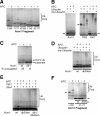Unique D box and KEN box sequences limit ubiquitination of Acm1 and promote pseudosubstrate inhibition of the anaphase-promoting complex
- PMID: 18596038
- PMCID: PMC3259782
- DOI: 10.1074/jbc.M803695200
Unique D box and KEN box sequences limit ubiquitination of Acm1 and promote pseudosubstrate inhibition of the anaphase-promoting complex
Abstract
The anaphase-promoting complex (APC) regulates cell division in eukaryotes by targeting specific proteins for destruction. APC substrates generally contain one or more short degron sequences that help mediate their recognition and poly-ubiquitination by the APC. The most common and well characterized degrons are the destruction box (D box) and the KEN box. The budding yeast Acm1 protein, an inhibitor of Cdh1-activated APC (APC(Cdh1)) also contains several conserved D and KEN boxes, and here we report that two of these located in the central region of Acm1 constitute a pseudosubstrate sequence required for APC(Cdh1) inhibition. Acm1 interacted with and inhibited substrate binding to the WD40 repeat domain of Cdh1. Combined mutation of the central D and KEN boxes strongly reduced both binding to the Cdh1 WD40 domain and APC(Cdh1) inhibition. Despite this, the double mutant, but not wild-type Acm1, was poly-ubiquitinated by APC(Cdh1) in vitro. Thus, unlike substrates in which D and KEN boxes promote ubiquitination, these same elements in the central region of Acm1 prevent ubiquitination. We propose that this unique property of the Acm1 degron sequences results from an unusually high affinity interaction with the substrate receptor site on the WD40 domain of Cdh1 that may serve both to promote APC inhibition and protect Acm1 from destruction.
Figures





References
-
- Peters, J. M. (2002) Mol. Cell 9931 –943 - PubMed
-
- Hershko, A., and Ciechanover, A. (1998) Annu. Rev. Biochem. 67425 –479 - PubMed
-
- Cohen-Fix, O., Peters, J. M., Kirschner, M. W., and Koshland, D. (1996) Genes Dev. 103081 –3093 - PubMed
-
- Funabiki, H., Yamano, H., Kumada, K., Nagao, K., Hunt, T., and Yanagida, M. (1996) Nature 381438 –441 - PubMed
Publication types
MeSH terms
Substances
LinkOut - more resources
Full Text Sources
Other Literature Sources
Molecular Biology Databases
Miscellaneous

